Description
Note: Any assessments should be done by a licensed physical therapist as this is not within the scope of practice for a Pilates teacher.
About This Video
Transcript
Read Full Transcript
Hi, I'm Sherry bets and we'll be talking about Sciatica today and seems to be a major problem in a lot of different Pilati studios and [inaudible] out there in the world and it can be generated from a lot of different things. So just because you have Sciatica doesn't mean you have the same kind of psychotic provocation as someone else. So a lot of people say, oh, well I did this exercise for it and it really helped. And then you'll do that exercise and it doesn't really help you because you don't really know what's causing this at USCCA. So I feel like my job as a PT is to kind of weed that out and to help people find out what the cause of their Sadeq is. So I'll tell a few different scenarios where I'm the first person, if you would, if you look at, um, the psychotic, um, I'm sorry, this sacred Iliac joint tutorial, I did a pretty thorough, um, differentiation test of using the slump test and straight leg raise test.
So I feel like that's the most comprehensive assessment of someone that you could see how we do that. And how we tease that out and see what's going on. So the first place that the side nerve can be irritated is if you're doing a seated position and you have pain and sitting and I do a slump test where you're slumping down like this and your hands are behind your back and you just let your head drop. And if the person says, I have pain with that, and then I would ask them to lift one leg and then flex the foot like that and see if that brings pain down the leg. If they have that same symptom, uh, it may likely be a disc problem. I can also add pressure here to see if it's a disc problem. So I try to go from proximal to distal with this to see is it, is it right there where the nerve comes out of the pathway and the disc is bulging into the nerve and um, see if that's provoking it. If standing and forward bending provoke the pain, that could be an indicator that that's a disc problem.
Cause this is actually the same position. So if you're in the Palati studio and you notice somebody's in stomach massage or in spine stretch is having pain down their leg, then they could be having a disc problem. So it not might not be though. So you want to, you want to make sure that you don't say, Oh, you probably have a disc problem. Right. Because I don't even know if that person has a disc problem. Even if they say they have the penguin down their leg.
So I look at that and then I would see, do they have pain? If I don't have pain with that, then do they have pain with extension? Then that indicates that they might have stenosis, which I did a tutorial on that as well. And you can see that on online as well. Um, so that would mean that the person has pain when they walked down hill, whereas that's a stenosis type pain. If they walk uphill. Right. And they get relief, it's probably not stenosis, right? They're probably not.
Um, uh, it could be certainly not a disc problem. Um, so if they get pain when they walk uphill, that could be because they're forward flexing their trunk to get uphill. Right? And that could mean that they have a disc problem. So it's, it's tricky. So there's a lot of different generators of pain. Then if we move down the pathway a little bit, I'm going to have you lay on your stomach, move down the pathway a little bit. And so we see here, this is the, the psis area. I'm gonna Bring your pants down a little bit, Amy. Thank you.
And this is the psis area right here. And then if I go just up and in, I'm going to be right on l five s one, so I could push around there and see if she has tenderness or pain there. And does that provoke your radiating pain down the back of your leg? And again, that's not what you'd be doing as a Polonius teacher, but this is what I'd be doing as a PT to kind of tell the difference as to what's provoking your pain. If I know that provokes your pain, I know that's going to be the pain generator right now. If I come down a little further and I look at all of those sacroiliac joint tests, which could be positive and could cause some pain down the leg as well, then I could say, okay, it's your psych really act joint. Then the next thing that we haven't really talked about is the Piriformis and the piriformis attaches to the sacrum and originates under the sacrum and goes out to the outer hip and it is an external rotator of the hip. So if that is often the pain generator than it may be that the Piriformis is clamping down on the side nerve and in 15% of people, the psychic nerve goes right through the piriformis muscle and you can see if that muscle was really tight. It's at this angle actually. Um, if you can see if that muscle was really tight, it's pinching that side of nerve a little bit and that could be the problem.
And then people that benefit from performa stretches and say, oh, that makes me feel better. Then they probably have that as the problem with their SCIATICA. Now other things that can create issues are, you know, if there is a, uh, maybe, uh, an old hamstring injury or scar tissue in the abductors, um, anywhere along that side of nerve pathway, then that can grab onto the nerve as well and be a problem with, with Sciatica. I had a gymnast once that had a hamstring tear and it was right where the hamstring tore and it was kind of grabbing onto the Sadik nerves. So I had to do a lot of soft tissue work and nerve glides in order to get that freed up for her. And then once that got freed up, she was like, oh great, I can move my leg now and it doesn't hurt.
Then the other places I've seen problems are, I remember one lady had pain in the outer ankle here and inner outer fluid. She thought she had a foot problem, so she went to the orthotics person and got some orthotics made and all that stuff. And all we found was if you want to lay on your back, Amy, all we found that was the issue with her. So I'm just gonna pretend like it was the right side. Um, was she had an old ankle sprain that had craze and scar tissue. We sank. I can't prove that, but that was grabbing onto the nerve. So she did her little nerve glides, flexing the foot this way was what brought it on.
And she did those for two or three days and she never had the pain again. So that was so fun. Um, and one of my plots teachers actually brought her to me and said, can you assess her to see why she's having this pain, why you think she's having this pain? And as it turned out, it was a, again, psychotic nerve. The, the peroneal portion of the nerve was caught in that scar tissue. And then once we freed that up, she was fine. Um, but that's not something that I would spec expect the ploys teacher would be able to do. But my Polonius teacher, I saw her one time, she went back to my polarities teacher. And continued on with her sessions and added in the straight leg raise stretch with the glides. So here taking the leg up, you're going to see this often from the other other series.
So even with the stenosis, take it across like that. And then you're going to flip that flip down in and out round. So what we do is we find the provoking position. You hold that position, make sure the pain is not there, and then when you point or take the stretch off the nerve, the pain goes away and then you flex and point. Okay, so very similar to the segment we did on Stenosis, right? So if you have, again, Sciatica or leg pain down that leg, the provoking factor is where is that nerve getting pinched or caught or pulled.
And what you want to do is to try to figure that out and then then free that nerve up. Um, the other exercises that are great for if there's a disc problem, so if you have a disc problem that is caused by the psychotic, it's all about extension. So you do repeated extension with that. And I have you turn over on your stomach. And then, so say there's a disc bulge and it's bulging out to the left and she's got left buttock and leg pain. And then when I have her lay on her stomach and get her hands under her shoulders, elbows toward the feet, and then she pushes up into ice swan and you're gonna do a Saggy Swan. And I want you just to do a saggy swamp and then come back down and then come up into that saggy swamp position. They'll say, if it is a disc related problem, they'll say that that relieves their pain and then come down Saggy Swan. I know it's not good. Yeah. So again, saggy Swann and up.
So you'll just do repeated extension 10 or so times and you'll start to notice what we call centralization. And you'll want to keep, you know, the feeling of that pain moving up the leg or it may intensify in the back and actually that's progress to get the pain out of the leg and get it to intensify. And the low back is actually good. Um, and you have to, you know, tell your client then that it's going to feel better, um, as they go into it. And if you're getting the pain out of the leg, that's progress. It will usually get worse in the back. But that's when you have to, you know, kind of start to work on lengthening and stretching and things like that. So now get up on your elbows. So once the pain and stay on your belly and go down all the way flat. Yup. And just up on your elbows, it's kind of like a double like kick position, double leg, strip, strip, um, single leg kick position, sorry. And then, um, I want to try to get the low belly to lift and get her into a, a really supported position of that pelvis and exactly like that. And then bend your knee
Now come up onto a hands and knees
And then I asked them when did they get that picture made? And they said that, oh, 15 years ago. So it's like, well you probably don't have a disc bulge for 15 years. Um, disc can heal the disc fluid can imbibe and become more healthy on the tissues can heal and you don't have a disc bulge for the rest of your life once you have it. So introducing flection is usually the scariest thing to a disc patient. Right? Um, so put your hands behind your knees and bend your knees [inaudible] and then just going to start to gently roll down. I, you can certainly use the springs with this and rolled down and keep holding onto your legs and don't let go of your legs. You're going to stay here and try to keep your feet on the floor as long as you can and then come right back up and just hold onto your legs right here. And then roll back and you're going to start to introduce fluxion a little bit
And skip forward just a little bit. I want to make sure your head's not going to be too far. Okay. Roll back and then bring your legs with you and roll all the way down. [inaudible] good. All right. Then bridging is another place too to add in some flection. So curling here, doing in articulating bridge and enrolling down one bone at a time as you lengthen. My favorite, favorite, favorite exercise for disc problems. If they get flared up during their session, which can happen when they're kind of fresh and healing is to get some, some of that length between the the ribs and pelvis and activating glutes and lats at the same time as super helpful.
So what exercise do we know about that that will, that will facilitate. So breathing on the trapeze table is a great exercise to do with someone with a hot desk. We've got a hot desk because sometimes I'll get flared up during the session. You're like, oh no, what do I do now? You know? So that would be a great choice because that gives them traction and you don't even have to do anything, right?
You don't have to pull on them or do anything to them. You can put their feet in this trapeze and then have them do the pull down with the bar. And I don't do it any differently than you would do it in your teacher training program. It's just I get up there and kind of hold their heels in place a lot of times and have them do the roll up and roll down. But if you don't have that opportunity, you can just hold onto the back of the legs, get your kids at home to hold your, hold the back of your legs while you roll up and roll down.
And people will usually say, oh, it feels so good and certainly helpful. So for starters, you want to, um, kind of figure out where the entrapment is along that pathway of that nerve. Then, um, what if you find that it's a disc, then you start to introduce flection and the pelvic tilt is a really good place to do that. And then up into the bridge and of course pelvic stability, core control, all the good stuff that you already know about from the other tutorials as well. Abdominal strengthening is helpful because you want to reduce the gripping in the back. That usually happens with disc pain and activate the abdominal wall.
And then, um, when you start to introduce more loaded flection, very gently with the seated bent knee position with springs to assist, really helpful there. And then, um, get going to the full straight leg roll up and wrote down, which should probably, it may be a long time before they start to do the full spine stretch forward while you're sitting and stretching forward. Um, so go ahead and roll up Amy, uh, with the hands behind your thighs and uh Huh. Okay. She doesn't have a lot of Lumbar flection, so that's really hard for her. Yeah, that was good. All right now, so straighten your legs out, reach your arms straight out. So one thing I love about the springs is that it gives her a little bit of assistance with that position or the push three bar. Super helpful with introducing some flection and then back up again.
Right. And then she can roll back through here and really try to get that low belly to pull back and then sit up tall. Excellent. Um, okay. So I think that's a good for looking at Sciatica from a different Lens and figuring out where it's coming from is really important. So I hope to see you at another tutorial. Thanks for joining me.
The Teacher's Corner: Common Back Problems
Comments
You need to be a subscriber to post a comment.
Please Log In or Create an Account to start your free trial.
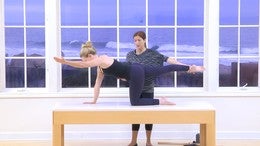
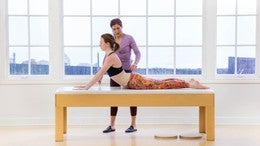
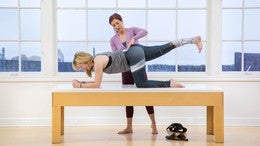
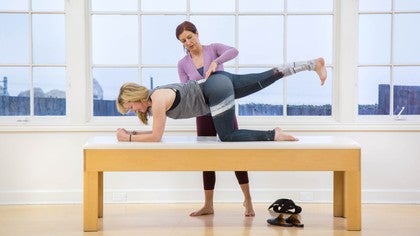
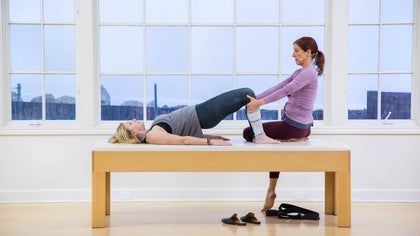
















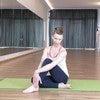
 this is all very helpfull
this is all very helpfull 

